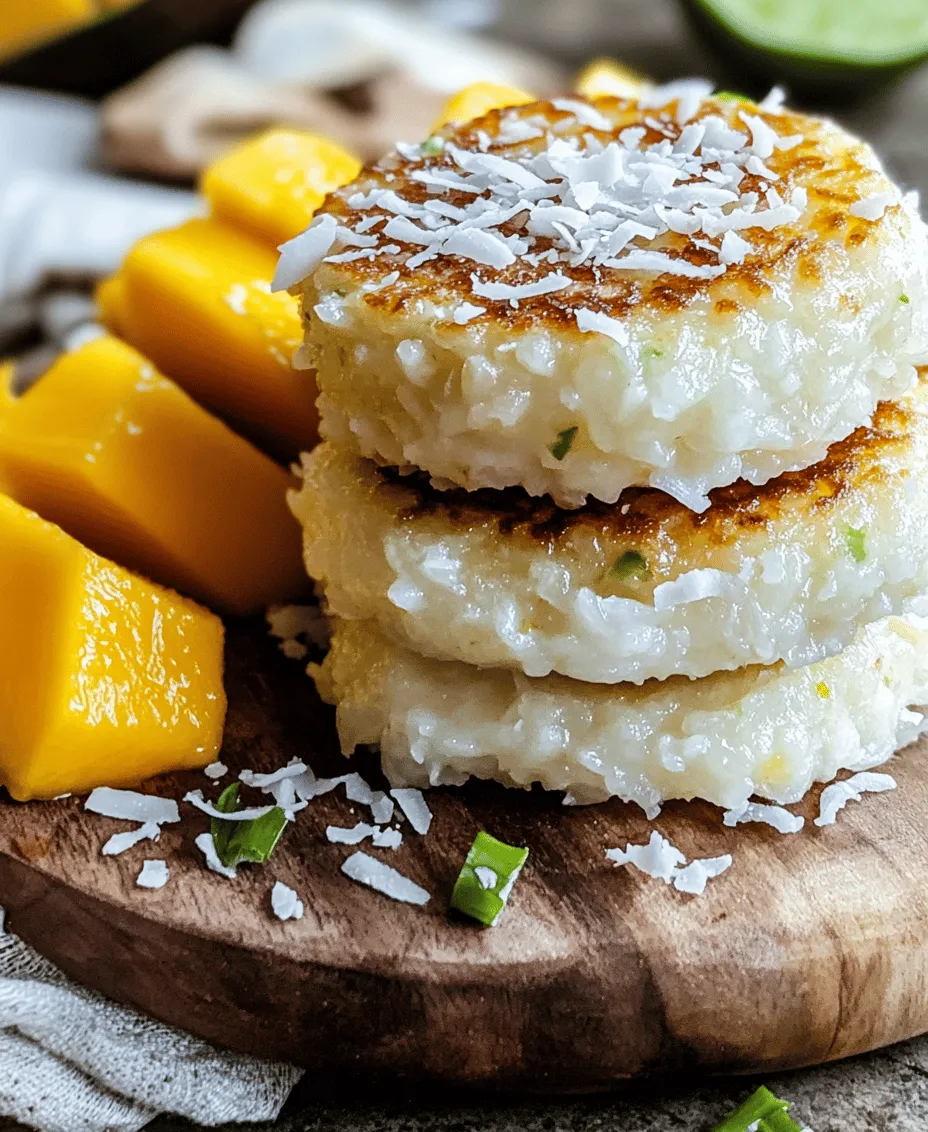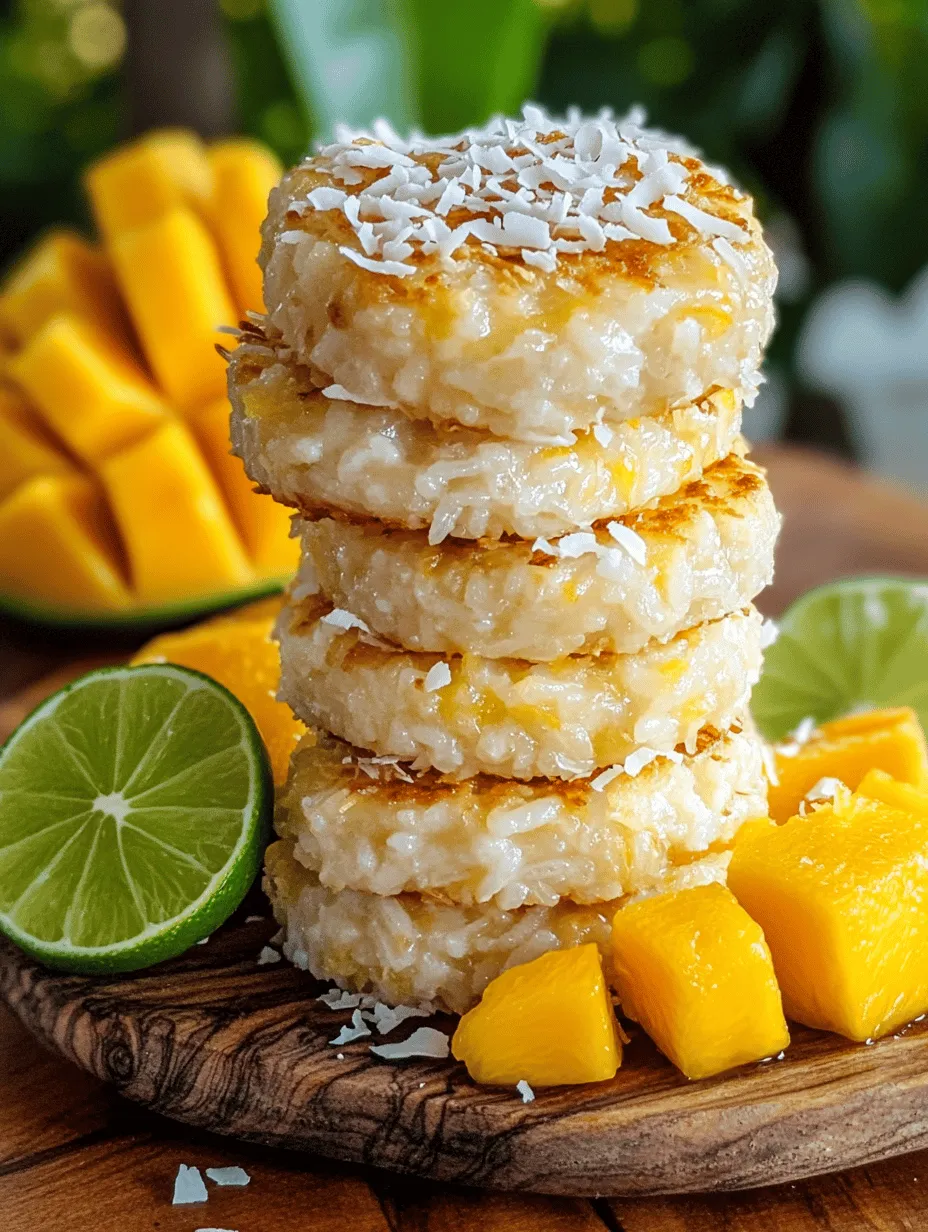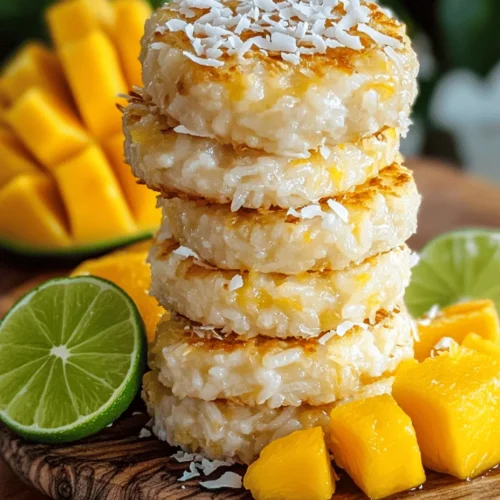Introduction
Welcome to the delightful world of Tropical Coconut Rice Cakes, a sweet treat that captures the essence of paradise in every bite. This recipe is a harmonious fusion of aromatic jasmine rice and the creamy richness of coconut milk, resulting in a unique dessert or snack that tantalizes the taste buds. Imagine sinking your teeth into a soft, chewy rice cake that has absorbed the tropical flavors of coconut and is subtly sweetened to perfection. Whether you are looking to impress your guests at a gathering, seeking a delicious snack to enjoy alone, or wanting to introduce your family to a new favorite, these rice cakes are sure to leave a lasting impression.
Originating from Southeast Asian cuisine, coconut rice cakes are a popular option that showcases the culinary artistry of using local ingredients. They are often enjoyed during festivals, celebrations, and even as street food in various regions. The simplicity of the ingredients combined with the complex flavors makes this dish not only approachable for home cooks but also a rewarding experience for those who savor the process of creating something special.
In this article, we will take you through the essential ingredients that make up these delectable rice cakes, detailed step-by-step instructions on how to prepare them, and some creative serving suggestions to elevate your culinary experience.
—
Understanding the Ingredients
Jasmine Rice: The Foundation of Flavor
At the heart of Tropical Coconut Rice Cakes lies jasmine rice, a long-grain variety known for its delicate floral aroma and slightly sticky texture when cooked. The importance of using jasmine rice cannot be overstated; it provides a unique flavor profile that complements the coconut perfectly. When cooked, jasmine rice becomes tender and fluffy, creating a delightful base for the coconut mixture.
From a nutritional standpoint, jasmine rice is not just a delicious choice; it also offers several health benefits. It is a good source of carbohydrates, providing energy for your day. Additionally, jasmine rice contains essential vitamins and minerals, including B vitamins, iron, and magnesium. Opting for whole grain jasmine rice can further enhance its nutritional value, making it a wholesome ingredient for your rice cakes.
Coconut Milk: The Creamy Element
Coconut milk is the star of this recipe, adding depth and richness to the rice cakes. It is important to distinguish between different types of coconut milk available in the market. Canned coconut milk is often thicker and creamier, making it ideal for desserts, while fresh coconut milk can add a more vibrant flavor if you have access to it. When selecting coconut milk, look for brands that offer a high-fat content, as this will contribute to the creaminess of the final product.
In addition to its delightful taste, coconut milk is packed with health benefits. It contains medium-chain triglycerides (MCTs), which are known to support energy levels, weight management, and overall health. It is also rich in vitamins C and E, both of which are powerful antioxidants that help protect the body from free radicals.
Sweeteners and Flavorings
The balance of flavors in Tropical Coconut Rice Cakes is crucial, and this is where sweeteners come into play. Traditional recipes often use sugar, but you can also experiment with alternatives like honey or maple syrup for a unique twist. The sweetness enhances the natural flavors of the coconut milk and jasmine rice, creating a perfectly balanced treat.
Moreover, a pinch of salt is essential in this recipe. While it may seem counterintuitive to add salt to a sweet dish, it helps to enhance the overall flavor profile, bringing out the sweetness of the sugar and the richness of the coconut.
To add depth to the flavor, a splash of vanilla extract is also included. Vanilla not only complements the coconut and sugar but also elevates the overall sensory experience of the dish, making each bite even more enjoyable.
The Role of Cornstarch
Cornstarch plays a vital role in achieving the perfect texture for Tropical Coconut Rice Cakes. It acts as a binding agent, helping to hold the rice cakes together while also providing a pleasant chewiness. This gluten-free alternative is particularly useful for those with dietary restrictions, making the dish accessible to a broader audience.
When mixed with the cooked rice and coconut mixture, cornstarch helps to create a cohesive blend that forms the foundation of each rice cake, ensuring they hold their shape while remaining soft and tender.
Toppings: Enhancing the Experience
While the Tropical Coconut Rice Cakes are delicious on their own, the right toppings can take them to the next level. Consider adding fresh fruits like mango, pineapple, or berries, which not only enhance the visual appeal of the dish but also provide a refreshing contrast to the rich coconut flavor. Drizzling a little extra coconut cream or a sprinkle of toasted coconut flakes can add texture and an extra layer of tropical flavor.
For those looking to incorporate a hint of crunch, you might consider nuts such as chopped cashews or almonds. These toppings can add a delightful contrast to the soft rice cakes and create a more complex flavor profile that will surely impress anyone lucky enough to enjoy them.
—
Preparing Tropical Coconut Rice Cakes
Rinsing the Rice: A Crucial First Step
Before diving into the cooking process, it’s essential to prepare the jasmine rice properly. Rinsing the rice is a crucial step that should not be overlooked. This process helps to remove excess starch from the surface of the rice grains, which can lead to a gummy texture when cooked. Instead, rinsing ensures that the rice cooks evenly and maintains a fluffy consistency.
To effectively rinse jasmine rice, place it in a fine-mesh strainer or a bowl and cover it with cold water. Gently swish the rice around with your fingers, allowing the water to become cloudy. Drain the water and repeat this process several times until the water runs clear. This simple step will significantly enhance the texture of your final dish.
Cooking the Rice Mixture
Once the rice has been rinsed, the next step is to cook it to perfection. In a medium saucepan, combine the rinsed jasmine rice with the appropriate amount of water and a pinch of salt. Bring the mixture to a boil over medium-high heat, then reduce the heat to low, cover the pot with a lid, and let it simmer for about 15-20 minutes.
It’s important to avoid lifting the lid while the rice is cooking, as this can disrupt the steaming process. After the cooking time is complete, remove the saucepan from the heat and let it rest for an additional 10 minutes. This resting period allows the rice to finish cooking through residual heat, resulting in perfectly tender grains.
After the resting time, fluff the rice with a fork to separate the grains before proceeding to mix it with the coconut ingredients.
Creating the Coconut Mixture
Now that the rice is cooked and fluffy, it’s time to create the heavenly coconut mixture that will bring your Tropical Coconut Rice Cakes to life. In a mixing bowl, combine the cooked jasmine rice with coconut milk, sugar, a pinch of salt, vanilla extract, and cornstarch.
Stir the mixture gently until all the ingredients are well incorporated. It’s essential to ensure that the cornstarch is evenly distributed throughout the mixture, as this will help bind the rice cakes together. The combination of the creamy coconut milk and the sweet notes from the sugar will infuse the rice with a tropical flavor that is simply irresistible.
Once the coconut mixture is ready, it’s time to move on to the exciting part – shaping and cooking the rice cakes, which we will cover in the next section.
By following these steps, you are well on your way to creating Tropical Coconut Rice Cakes that are not only delicious but also a testament to the vibrant flavors of the tropics. Stay tuned as we dive deeper into the preparation process, ensuring you have all the tips needed to achieve the perfect rice cake every time.




